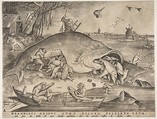Big Fish Eat Little Fish
Pieter van der Heyden Netherlandish
Pieter Bruegel the Elder Netherlandish
Publisher Hieronymus Cock Netherlandish
Not on view
One of the most haunting of Bruegel's images, Big Fish Eat Little Fish is among the first of the artist's many treatments of proverbs in paintings or prints. The image reveals many small and large fish tumbling out of the mouth of an enormous beached fish. A small, helmeted figure with an oversized knife slices open the big fish's belly, revealing even more marine creatures. Land, air, and water seem to be overrun by an odd assortment of real and fantastic fish, while in the foreground a man, accompanied by his son, gestures toward the scene. The meaning of his gesture is conveyed in the Flemish inscription below, which translates: "Look son, I have long known that the big fish eat the small." This vernacular form of the ancient Latin proverb, which appears in majuscule lettering just above, relates to the theme of a senseless world in which the powerful instinctively and consistently prey on the weak. That the son understands the lesson is apparent from his gesture toward the other man in the boat, who has extracted a small fish from a larger one. Bruegel's brilliant visualization of the proverb was first conceived as a drawing (Vienna, Graphische Sammlung Albertina) that is signed by the artist and dated 1556. This engraving by Pieter van der Heyden, however, is signed in the lower left corner with the name Hieronymus Bosch, who had died in 1516. The print's publisher, Hieronymus Cock, was probably responsible for replacing Bruegel's name with that of the more famous and salable Bosch, who had, not coincidentally, a major influence on Bruegel.
Due to rights restrictions, this image cannot be enlarged, viewed at full screen, or downloaded.


